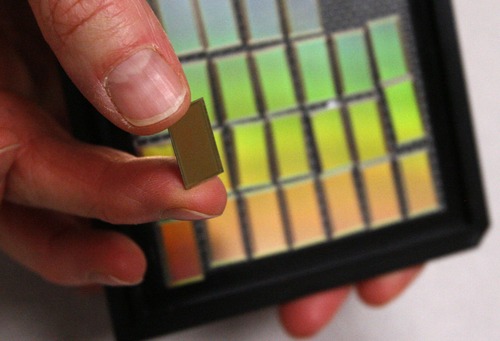This is an archived article that was published on sltrib.com in 2012, and information in the article may be outdated. It is provided only for personal research purposes and may not be reprinted.
There's Silicon Valley, of course, but Utah is kicking the concept of its "Silicon Slopes" into a higher gear with a new large-scale project near the Point of the Mountain.
Earlier this week, the Lehi City Council approved Micron's 735-acre business and housing development known as a "workplace neighborhood," where people can live, work, play and go to school all in the same place.
"It's the epicenter of economic activity ... in the state," said Kim Struthers, planning director for Lehi, noting that Micron's new economic baby — near 1500 East and 3400 North in Lehi — is projected to take its place near the sprawling new Adobe campus, the new Outlets at Traverse Mountain, Cabela's and operations for Microsoft, and Xactware.
Plans call for the Micron project to be built over the next 25 years and bring with it thousands of jobs. It seeks to build on the 4-year-old initiative pushed by others to brand the state's burgeoning tech industry and sell quality of life by evoking and highlighting the access to opportunities for outdoor recreation and the lifestyle that provides.
Doug Meldrum, economic development director of Lehi, said the timing is right for more growth in the teeming area. Thanksgiving Point is the population center of Utah and "seems to be the nexus of what is going on."
Micron plans to build around the exterior of the IM Flash Technologies center it operates with Intel to produce flash memory chips used to store data in music players, cameras and other digital devices. The development plan includes 780 housing units, including town homes, condominiums and single-family homes.
"Given Lehi's ideal location and the physical attributes of the Micron site, we believe this development will clearly identify Lehi as the leading employment center for ... leaders of the future economy," Dennis Raney, Micron's project consultant, said in a news release.
Managing the extremely quick growth of the area will be a "difficult task," Meldrum acknowledged, but the city will be working to preserve the "small town atmosphere," while trying to ensure a balanced development.
"We are already growing at an extremely high rate," Meldrum said, adding that its homebuilding rate of 61 units per month is the second highest in the state next to Daybreak for residential building.
Within the steep terrain and mountain vistas, Micron foresees a "workplace neighborhood" that provides open space, and developed walkways and trails that would make up 36 percent of the planned development.
"That is kind of one of the goals — to preserve some of the natural areas," Lehi's Struthers said, adding that the system will connect to local trails, including the Bonneville Shoreline trail.
Plans call for about 28 percent of the property to be filled with office space, and additional areas with retail shops and mixed-use buildings.
A technical/manufacturing area would occupy about 90 acres, while about 52 acres would be residential. Population projections show there would an estimated 1,100 school-age students for an elementary school and middle school within the project.
Road access will connect the development to State Road 92 as the main entrance, but also include other outlets to Highland Boulevard and Traverse Ridge Road. As things develop, lehi officials envision building more roads to better connect the northeast portion of Lehi to the two-county city of Draper.
Transportation options also include connecting the project to future bus systems, FrontRunner and a future TRAX line.
The pressurized irrigation and culinary water will be serviced by Lehi water, but not without its own secondary reservoir being built.
"There will be some expansion and new facilities to accommodate that," said Lehi Water & Waste Water Superintendent Lee Barnes.
Twitter: @CimCity



